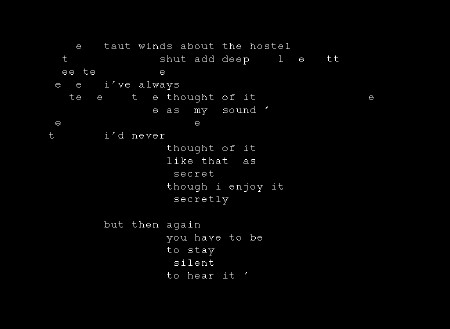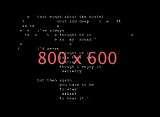windsound
multimedia, custom software, 2001; performance transcribed as digital video, 2006
windsound is a poetic and narrative 'text movie' with transliteral morphing. The nodal texts were written by the author, and the work also includes the author’s translation of a Song period classical Chinese lyric, ‘Cadence: Like a Dream’ by Qin Guan (1049-1100).
windsound won the 2001 Electronic Literature Organization prize for poetry. Amongst other things, the judge, Heather McHugh had this to say about it:
A bravura belle-lettristic performance that could have existed in no other medium, windsound reveals the power of letters, even as it plays with the limits of literal intelligibility. It explores the power of sequences, even as it plays with non-sequitur. All the more elegant for its austerities, this work was composed exclusively for alphabet and windpipes. Material both visual and vocal, both structural and semantic, is constantly dissolving and re-solving, and giving rise to a host of readerly impressions. Fields of floating phonemes and morphemes sometimes seem to assemble into patterns—form meaningful phrases and sentences—only to morph away again, before our ears and eyes. Never has a visual field so significantly deepened the psychic impression of Freud’s 'mystic writing pad'—the appearance and disappearance of the writing on which Freud famously likened to 'the flickering up and passing away of consciousness in the process of perception.'
McHugh's remarks encouraged me to think more about the apparatus of literal processing in a subsequent essay, inner workings.

In January 2006 I made a 'QuickTime rendition' of windsound. This made it 'cross-platform' for the first time (so long as you have QuickTime installed in some form). A browser-viewable mp4 version of this movie is provided here (as of Spring 2018).
l a u n c h w i n d s o u n d
In this rendition windsound is presented as a twenty-three minute digital video. In the original version of windsound (for Hypercard) the transliteral morphs—and resulting transitional states of the text—were software-generated, and the speech synthesis was 'live.' This video rendition is, however, a more or less conventional movie: the record of one of many potential performances.
. . . . . . .
to download the original HyperCard version
The HyperCard version of this work is still for Macintosh only. 'windsound' requires (as minimum): - an Apple PowerMac computer with about 32 Mb RAM; - system 8.6 or better; - Macintalk Pro (speech synthesizer) installed, including the voices: 'Bruce, high quality', 'Victoria, high quality' and 'whisper'; - the fonts Monaco and Courier installed; - a display of at least 800 x 600 pixels. Under Mac OS X 'windsound' runs under in the Classic environment.
If you have a suitable Mac, all you need is the download. The download is approximately 1 Mb and it will start immediately if you click the link below.
You may download the standalone version of windsound and its associated files packed into the archive 'windsound.sit' from: http://programmatology.shadoof.net/?downloads which will load into this frame after you click the link. (Nb: you can also download the QuickTime version from this page.)
r e a d i n g w i n d s o u n d
starting up and closing down
To start: double-click windsound (stack/application icon).
To close: either let the performance finish and click 'END' or to exit quickly Command-[full stop] and Quit.
reading
- To read windsound in 'full screen' mode (recommended), set your monitor to 800x600 pixels.
- Once 'windsound' is open simply click the 'Begin' button.
- 'windsound' is designed to be watched and read like a film. The complete showing takes about 20 minutes. Ideally, you should just watch it through to completion. However, there are a few simple controls:
- pressing and holding down the shift and command keys returns
to the beginning of the 20 minute sequence and/or allows a clean
exit using the 'End' button;
- pressing and holding down the option key skips (after a short
time) to the 'credits' section of the sequence (which is integral
to the piece).
- When reading 'windsound' you should: 1) see animated text, 2) hear a
continuous low-level audio track, and, at various appropriate times,
3) hear synthesized speech from one or other of the three voices.
a few more more notes
The nodal texts of 'windsound' were written expressly for the piece. My own translation of a Song period lyric, 'Cadence: Like a Dream' by Qin Guan (1049-1100) is also used.
Although 'windsound' plays as an all-but-linear movie, the transitional texts are algorithmically generated. Later pieces, further developing these principles, are both navigable and have transitional phases which are generated 'on the fly'.

